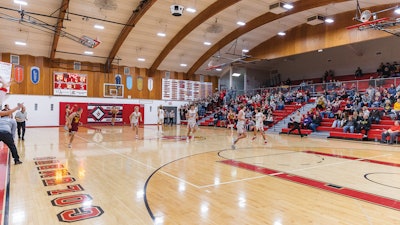
Today’s athletics facilities serve as more than just venues for competition — they’re multipurpose spaces that host everything from daily practices to graduations and community events. Behind every successful athletic program lies infrastructure that often goes unnoticed until it fails, and the sound system for any facility is an integral part of that infrastructure.
Chris Barrow, senior product manager at Biamp, has spent years helping schools optimize their audio experiences. According to Barrow, the evolution of sound system technology has created new opportunities for truly integrated solutions across campus.
“I don’t think a lot of schools quite yet think of a centralized system,” Barrow explains. “We haven’t had the technology to do that very well until fairly recently.”
What follows are insights from Barrow on the benefits of installing or upgrading to a dependable, integrated sound system.

The integrated approach
Traditional approaches to school audio have typically treated each space as an island, with separate systems for gymnasiums, football stadiums, auditoriums and hallways. This fragmented approach often results in maintenance headaches, inconsistent user experiences and missed opportunities for operational efficiency.
“We’d love for any school that calls us to do a gymnasium and want an auditorium or their football field outside, to also think about us when they install paging systems, too, and have it all centrally monitored,” says Barrow.
The advantages of an integrated system extend far beyond convenience. For athletic directors and facility managers, perhaps the most compelling benefit is proactive monitoring.
“One of the big advantages of having everything monitored by one system is having offline monitoring of all of the equipment between uses,” Barrow points out. “Everything is online, we know way ahead of time before there’s any issue. The contractor who installed it actually can be monitoring this on a service contract and get out there and fix it before the school even knows anything’s wrong.”
 Image courtesy of Biamp
Image courtesy of Biamp
Starting fresh vs. adding on
When schools approach sound system upgrades, many initially hope to simply add to their existing equipment. Barrow cautions against this approach.
“When people ask us to look at a system, often they will go to our dealer and say, ‘Hey, I’d like to add on.’ Hopefully, by the time the request gets to us, the dealer’s already told them that just adding on to what they have probably is not going to get the results they want.”
The challenge, Barrow explains, is that modern expectations for audio quality have risen dramatically, influenced by consumer technology that delivers impressive sound from increasingly compact devices.
“That’s one of our biggest challenges — what expectations are these days. We all have little tiny boxes that appear to make tremendous amounts of bass and amazing sound quality everywhere we are, without having a giant system. So just putting up a couple of 15-inch two-ways in the gymnasium doesn’t quite provide that same feeling.”
Instead, Biamp typically recommends starting fresh with an assessment of coverage needs and acoustic challenges.
“Turning off the old system is usually a better idea than trying to add to it,” he says, “because it’s probably not aiming the right way. It’s probably not actually pointed at the people.”

The multipurpose challenge
Modern athletics facilities increasingly serve multiple functions, with gymnasiums doubling as assembly halls and event spaces. These “gymnatoriums,” as Barrow affectionately calls them, present unique audio challenges.
“That space does a little bit of everything,” he notes. “In that case, you’ll have speakers in there meant for when the gymnasium is in use, but we will design a different system for the stage, because you want speakers by the stage, on the proscenium, coming at the audience from when the people are on the stage.”
Even within a gymnasium, flexibility is key. “A lot of gymnatoriums are divisible spaces where you actually have three or four gyms in one room with the divider walls,” Barrow explains. “We have to handle those spaces a lot like you would a hotel, where you want to be able to divide those rooms.”
User-friendly control
Perhaps the most transformative aspect of modern systems is the simplified control interface. Gone are the days when operating a sound system required specialized training.
“We’re democratizing this space where we want everything to be drag and drop, push one button,” says Barrow. “I ask for the magic button all the time in every project. That’s really what we want.”
Today’s systems feature customizable touchscreen interfaces that can be mounted anywhere in the facility. “We can design a simple control interface on our touch panels that we can hang on a wall anywhere in there. That becomes your volume control, your source selection, your room divide and undivide,” Barrow says. “It’s all fully customizable. You can design whatever control surface you want.”
This flexibility extends to creating preset configurations for different scenarios and addressing common complaints about excessive volume during games or events.
“We can set preprograms with the push of a button and say, ‘Okay, put it on the 10 dB down position so we’re not killing people,” Barrow notes. “But a lot of that comes down to design, as well. A customer may ask for their football field to have an end zone system and not really think about what happens to those folks who are right there in the end zone next to those speakers.”
 Image courtesy of Biamp
Image courtesy of Biamp
Cloud-based monitoring
The latest evolution in audio system management is cloud-based monitoring, which allows for remote oversight of all connected components.
“All of our stuff is very distributed. It’s very scalable,” explains Barrow. “We’re not giving you one giant box that runs everything. Each space has its own small pieces of equipment that do just what that space needs. The important thing is it all runs back up to the cloud so we can monitor it. And that’s really the magic.”
This approach aligns with shifting responsibilities within schools, where audio systems increasingly fall under IT department oversight rather than dedicated audio personnel.
“More and more commonly, that’s coming under the IT department,” Barrow says. “A lot of schools don’t necessarily have just an audio guy there. From the IT department, they might not even know what’s wrong with the system. They just get a red flag and they call up their partner who they have a contract with.”
 Photo courtesy of Biamp
Photo courtesy of Biamp
Planning considerations
For schools planning new facilities or upgrades, Barrow stresses the importance of bringing sound experts in early during the design process. “The biggest bane of anybody’s existence are the afterthoughts and people prioritizing incorrectly in consideration with your budget,” he warns. “A lot of architects often get in before the acoustics people.”
This sequencing can lead to situations where acoustic treatments consume the budget, leaving little for quality speakers — or conversely, where excellent speakers are installed in spaces with poor acoustics.
“Getting with somebody who’s knowledgeable in sound” before finalizing budgets is crucial,” Barrow advises. Equally important is considering all potential uses for each space.
“Just making sure we have the control system built in to allow them to switch — even a football field,” he says. “We have a number of them where the players want music playing while they’re practicing. If you just set it up for gameday and don’t think about all the training days where it’s going to be used far more often — that’s definitely something you want to be thinking about.”
As technology continues to evolve, and the costs of video boards and other components decrease, the possibilities for integrated audiovisual experiences will only expand. For schools looking to maximize their investment in athletic facilities, a thoughtful, integrated approach to audio can transform not just gameday, but everyday experiences throughout campus.





































